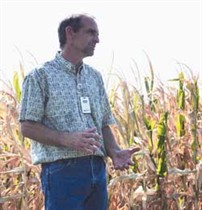Researcher examines soil testing methods
July 2009
By CLAY COPPEDGE, Country World staff writer
July 16, 2009 – Soil testing is widely recommended to farmers and ranchers who have to make decisions on how much fertilizer to apply to their fields or pastures, but an Agriculture Research Service researcher believes that the plant itself can be a more accurate analysis than a traditional soil test.

Dr. Rick Haney, ARS soil scientist at the Grassland, Soil and Water Research Lab in Temple, Texas, discusses methods of tracking fertilizer usage by the plant in order to determine the amount of fertilizer to apply. –Staff photo by Coppedge
peaking to producers at a recent Central Texas crops tour, ARS soil scientist Rick Haney said that not fertilizing is not an option, but over-fertilizing can be just as damaging to the producers’ bottom line and the land itself. Finding just the right amount of fertilizer to apply is the key, he said.
“Every corn plant is its own soil test,” Haney said. “We know how much nutrient uptake we need to grow a bushel of wheat, corn, or sorghum. Using that as a base, you can figure out your own fertilizer needs.”
On test plots at the Grassland Soil and Water Research Laboratory in Temple and on various farms in Central Texas, Haney has established test plots of between two and five acres. The plots are treated the same as the rest of the field except for two things: they do not receive fertilizer and they are harvested separately.
Using the results of a soil test that Haney has developed that checks levels of ammonium nitrate, phosphate and one-day CO2 (carbon dioxide) levels, Haney makes fertilizer recommendations for the field. By comparing the results from the fertilized and non-fertilized fields, it’s easy to see how many nutrients it takes to grow a crop, he said.
Noting that farmers usually put out about 22,000 seeds per acre to produce their annual yield, Haney said, “You use the yield from this field plot to calculate the nutrients removed by the crop. In other words, this calculation is essentially the plant nutrients that will be available for the growing season.
“It’s sort of like taking 22,000 soil samples per acre but only better because it eliminates all the steps necessary to analyze the soil and the margin of error associated with the analysis. It’s more exact, more precise.”
Using statistics from the 2007 Texas Agricultural Statistics Service, Haney estimates that producers from District 31, which includes about 813,000 cultivated acres, could have saved at least 35 pounds of nitrogen per acre.
“That’s also nitrogen fertilizer that isn’t applied to the soil, which reduces nitrogen loss from runoff that otherwise would end up in our lakes, streams and groundwater,” he added.
Much of Haney’s work for ARS is aimed at helping producers save money during a time of volatile fertilizer prices and uncertain markets. Even before input costs skyrocketed, Haney advocated using nutrients already available in the soil to save money on fertilizer.
“We can’t afford to over-fertilize, or to use a certain amount of fertilizer for no other reason than that’s how we’ve always done it or it’s how our fathers did it,” he said. “These have been some tough times, but it has taught us to be more efficient.”
Another tip Haney has for producers is in the calculation of liquid fertilizer, namely whether it should be applied by the gallon or by weight.
“Most liquid fertilizer concentrates weigh 10 to 11 pounds per gallon,” he said. “That means it makes about nine gallons of liquid to compare to 100 pounds of dry fertilizer. If the dry fertilizer costs nine dollars per hundred, you should be on guard if the liquid fertilizer of the same formulation costs more than a dollar per gallon.”
Fertilizers of the same grade, formulation, placement and rates give nearly identical responses whether liquid or dry, he said.
Producers interested in learning more about Haney’s soil-testing methods or those interested in having Haney conduct a test for them can contact him at (254) 770-6503 or at rick.haney@ars.usda.gov rick.haney@ars.usda.gov
